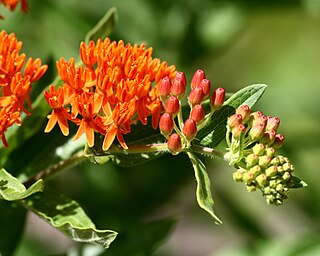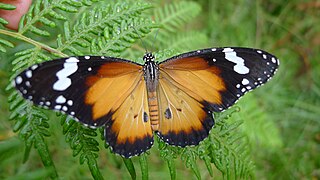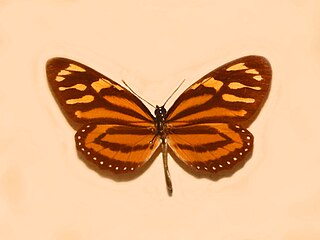
Danainae is a subfamily of the family Nymphalidae, the brush-footed butterflies. It includes the Daniadae, or milkweed butterflies, who lay their eggs on various milkweeds on which their larvae (caterpillars) feed, as well as the clearwing butterflies (Ithomiidae), and the tellervini.

Asclepias tuberosa, the butterfly weed, is a species of milkweed native to eastern North America. It is commonly known as butterfly weed because of the butterflies that are attracted to the plant by its color and its copious production of nectar. It is also the larval food plant of the queen and monarch butterflies. Hummingbirds, bees and other insects are also attracted.

The monarch butterfly or simply monarch is a milkweed butterfly in the family Nymphalidae. Other common names depending on region include milkweed, common tiger, wanderer, and black veined brown. It may be the most familiar North American butterfly, and is considered an iconic pollinator species. Its wings feature an easily recognizable black, orange, and white pattern, with a wingspan of 8.9–10.2 cm(3 1⁄2–4 in) The viceroy butterfly is similar in color and pattern, but is markedly smaller and has an extra black stripe across each hindwing.

Asclepias is a genus of herbaceous, perennial, flowering plants known as milkweeds, named for their latex, a milky substance containing cardiac glycosides termed cardenolides, exuded where cells are damaged. Most species are toxic. The genus contains over 200 species distributed broadly across Africa, North America, and South America. It previously belonged to the family Asclepiadaceae, which is now classified as the subfamily Asclepiadoideae of the dogbane family Apocynaceae.

Asclepias syriaca, commonly called common milkweed, butterfly flower, silkweed, silky swallow-wort, and Virginia silkweed, is a species of flowering plant. It is in the genus Asclepias, the milkweeds. This species is native to southern Canada and of much of the conterminous eastern U.S., east of the Rocky Mountains, excluding the drier parts of the prairies. It grows in sandy soils and other kinds of soils in sunny areas. It was one of the earliest North American species described in Cornut's 1635 work Canadensium Plantarum Historia. The specific name was reused by Linnaeus due to Cornut's confusion with a species from Asia Minor.

Asclepias incarnata, the swamp milkweed, rose milkweed, rose milkflower, swamp silkweed, or white Indian hemp, is a herbaceous perennial plant species native to North America. It grows in damp to wet soils and also is cultivated as a garden plant for its flowers, which attract butterflies and other pollinators with nectar. Like most other milkweeds, it has latex containing toxic chemicals, a characteristic that repels insects and other herbivorous animals.

The queen butterfly is a North and South American butterfly in the family Nymphalidae with a wingspan of 70–88 mm (2.8–3.5 in). It is orange or brown with black wing borders and small white forewing spots on its dorsal wing surface, and reddish ventral wing surface fairly similar to the dorsal surface. The ventral hindwings have black veins and small white spots in a black border. The male has a black androconial scent patch on its dorsal hindwings. It is found throughout the tropics and into the temperate regions of the Americas, Asia and Africa. It can be found in meadows, fields, marshes, deserts, and at the edges of forests.

Butterfly gardening is designed to create an environment that attracts butterflies, as well as certain moths. Butterfly gardening is often aimed at inviting those butterflies and moths to lay eggs as well. Because some plants are not fed upon by adult butterflies, the caterpillar host should also be planted for a bigger population of butterflies. Butterflies typically feed on the nectar of flowers, and there are hundreds of such plants that may be planted to attract them, depending on the location, time of year, and other factors. In addition to the planting of flowers that feed butterflies, other means of attracting them include constructing "butterfly houses", providing sand for puddling, water, and other resources or food items, including rotten fruit.

Asclepias curassavica, commonly known as tropical milkweed, is a flowering plant species of the milkweed genus, Asclepias. It is native to the American tropics and has a pantropical distribution as an introduced species. Other common names include bloodflower or blood flower, cotton bush, hierba de la cucaracha, Mexican butterfly weed, redhead, scarlet milkweed, and wild ipecacuanha.

The Danaini are a tribe of brush-footed butterflies. Their type genus Danaus contains the well-known monarch butterfly and is also the type genus of the tribe's subfamily, the milkweed butterflies (Danainae).

Cardenolide is a type of steroid. Many plants contain derivatives, collectively known as cardenolides, including many in the form of cardenolide glycosides. Cardenolide glycosides are often toxic; specifically, they are heart-arresting.
Robert Herbert Carcasson was an English entomologist who specialised in butterflies. He was director of the Natural History Museum in Nairobi from 1961 to 1968.

Danaus petilia, the lesser wanderer, is a species of butterfly in the nymphalid Danainae subfamily. It is a migratory species which is found in Australia and in tropical countries. Its larvae feed on native and introduced cotton bush species.

Eueides isabella, the Isabella's longwing or Isabella's heliconian, is a species of nymphalid butterfly, belonging to the Heliconiinae subfamily.
Tree nymph is another term for a Dryad in Ancient Greek mythology.

Lycorea halia cleobaea, the tropical milkweed butterfly, is a subspecies of Lycorea halia, also called the tropical milkweed butterfly, a nymphalid butterfly in the Danainae subfamily. It is found from the Antilles, Dominican Republic and the Caribbean. Its habitat is the tropical rainforest.

Lycorea halia atergatis, the tropical milkweed butterfly, is a subspecies of Lycorea halia, also called the tropical milkweed butterfly, a nymphalid butterfly family in the Danainae subfamily. It is found from Mexico, Venezuela and Colombia. Its habitat is tropical rainforest. It is sold commercially to collectors.

















